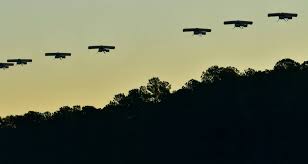drone swarm 1.jpg

Part 1 of 2 Parts
This is the age of the drone. From the size of insects to cargo hauling drones, these unmanned vehicles are exploding in variety and utility. Going beyond single drones, a lot of work is being poured into the creation of drone swarms which can work cooperatively. By definition, drone swarms are “multiple unmanned platforms and/or weapons deployed to accomplish a shared objective, with the platforms and/or weapons autonomously altering their behavior based on communication with one another.”
Today, I am going to focus on the use of drone swarms for military purposes. Drone swarms could be used for the delivery of different types of weapons including chemical, biological, radiological and/or nuclear. Such drones could travel in the air, on the land or in water to deliver deadly payloads. This blog will be about the use of drone swarms for nuclear offense and defense.
Drone swarms could serve as a new kind of nuclear missile defense system. They could even thwart hypersonic missiles currently being advertised as unstoppable. Swarms composed of thousands of cheap simple drones could be used to form defensive domes over high valued targets. Incoming missiles could be damaged or deflected by individual drones.
The same type of drone swarm could be used to form an aerial mine field, exploding on contact with nuclear bombers flying to targets. Even small drones could damage the wings and/or engines of aircraft. Low flying bombers hugging the terrain to avoid radar would be especially vulnerable to such air mines. In addition, short range drones could be used because they would need to cover less territory. Swarms of aerial, surface or submerged drones could be used to hunt for, follow, or even attack nuclear submarines.
Drones swarms could also be used for delivery of nuclear warheads. Research into such drone swarms is already being carried out by nuclear armed nations. They could also assist nuclear warhead delivery without needing to actually carry nuclear warheads themselves. Drone swarms could be used to confuse, disable or totally defeat the defense systems of enemies. Some missile defense systems are on mobile platforms and drone swarms are well suited to spread out and search broad areas for them. Drones could also masquerade as enemy aircraft to confuse and overwhelm air defense systems. Swarms of drones would be able to carry out coordinated maneuvers just like a fleet of aircraft to enhance the illusion.
It is possible that drone swarms could also assist in the targeting of nuclear warheads. Swarms of drones could be sent into enemy airspace to identify targets and gather information about defense system. Swarm principles could be applied to cruise missiles to allow them to coordinate to attack targets and avoid defenses. This would be particularly useful in what is known as counterforce strikes against military installation of an enemy. Such attacks require highly accurate and comprehensive identification of targets and precise strikes against such targets. Improving targeting is not as important for retaliatory strikes which deliberately target cities and civilians. More accurate targeting also means that less warheads and delivery systems are needed which reduces costs.
Please read Part 2